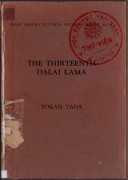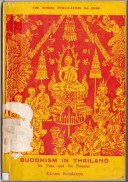Tìm Sách
Sách tiếng Anh-English >> Philosophy Of Hindu Sadhana
Thông tin tra cứu
- Tên sách : Philosophy Of Hindu Sadhana
- Tác giả : Nalili Kanta Brahma
- Dịch giả :
- Ngôn ngữ : Anh
- Số trang : 317
- Nhà xuất bản : Nalili Kanta Brahma
- Năm xuất bản : 1932
- Phân loại : Sách tiếng Anh-English
- MCB : 1210000004951
- OPAC :
- Tóm tắt :
FOREWORD
In ‘Hindu Sâdhanâ’ Dr. Nalini Kanta Brahma contributes a highly interesting and important work to the literature of Hindu Thought and Religion. His training as a student of Philosophy, his extensive studies in religious literature, and above all, his deep faith in the value of the Classical types of devotion and discipline, have enabled him to produce a book which will be invaluable to all students of Religion. The writer insists rightly on those characteristics of Hindu Religion which bring out its kinship with the higher religious thought of the world and also make manifest the attitude- of broad toleration characteristic of the Hindu Religion. The hook offers an illustration of what may be called the organic unity of higher religions. Though the writer’s interest is more on the practical side of Hinduism, there is a very clear discussion of the fundamental philosophical concepts underlying the Hindu Faith. I have no doubt that the book will be read widely by all those interested in Philosophy and Religion.
S. Radhakrishnan.
Waltair,
August 15, 1932
PREFACE
The theoretical side of Indian Philosophy has been ably presented in the monumental works of Sir Sarbapalli Radhakrishnan and Dr. Surendra Nath Das Gupta. I have attempted in the following pages a presentation of the practical side of Hindu Philosophy as manifested in the different religious systems of the Hindus. It has been my special endeavour to show the essential connection between theory and practice, and to point out the true significance of the course of discipline prescribed by the different religious systems for the attainment of spiritual realisation. The subject is so very wide that it has not been possible for me to deal in detail with everything that ought to fall within its scope, and I have been compelled to remain satisfied, in most cases, with merely a general treatment. I have confined myself to the discussion of the orthodox forms of Hindu Sadhana, and have not included Buddhistịc and Jaina Sâdhanâ in this work.
The First Part of this book is devoted to the discussion of the function and characteristics of Hindu Sâdhanâ in general. The Second Part deals with the particular forms of Hindu Sâdhanâ—Karma, Jnana and Bhakti. We have included the Yoga form of Sâdhanâ under Karma, and have taken the system propounded by Patanjali as representative of the Yoga line of Sâdhanâ. Although there are other forms of Yoga, such as Hatha-yoga, Laya-yoga etc., still they seem to be of the nature of preparatory disciplines, helping to make the vehicle,—the body and the vital processes, fit for the higher processes, and are not possibly meant to be independent methods of realisation. The Tântric method of Sâdhanâ has been included under the Bhakti line, because it emphasises the aspect of upâsanâ or worship.
I have avoided technical discussions as far as possible, and it is expected that the book will suit the general reader, excepting a few portions. Those who do not possess special knowledge of philosophy would, however, do well to omit Ch. II, the concluding pages of Ch. X, and a few pages of Ch. XI
I have not used italics for the Sanskrit words placed within brackets, as the brackets themselves, I think, mark them out sufficiently. Italics have not been used also for words that have become very familiar through repeated usage.
In the Appendix, I have explained some of the terms and expressions used in the book, which could not be dealt with more elaborately in the places where they occur.
A great deal of difficulty has been felt in judging as to how much of the details of Sadhana ought to be included and how much to be left out. Sometimes I have felt that I am introducing unnecessary details, sometimes, that I have become unjustifiably brief; I do not know whether I have succeeded in steering a middle course between the two.
CONTENTS
PART I – SADHANÃ IN GENERAL
Chapter I – The Relation of Philosophy to Religion
Chapter II – Sãdhanã: Its Place in Philosophy and Religion
Chapter III – Distinctive Features and the Stages of Hindu Sãdhanã
Chapter IV – Different Forms of Sãdhanã
Chapter V – A Historical Survey of the Forms of Sãdhana
PART II – SPECIAL FORMS OF SÃDHANA
Chapter VI – Karma-Mãrga or the Path of Action
Chapter VII – Karma-Yoga
Chapter VIII – The Yoga System of Patanjali
Chapter IX – The Path of Knowledge
Chapter X – How to Attain Knowledge
Chapter XI – The Path of Devotion
Chapter XII – The Nature of Devotion
Chapter XIII – The Determinants of Devotion
Chapter XIV – The Tantra Form of Sãdhana
Chapter XV – The Different Stages of Sãdhanã and the Synthesis of Its Different Forms in the Bhagavad Gĩtã
 Facebook
Facebook
 Google
Google
 Google+
Google+


















